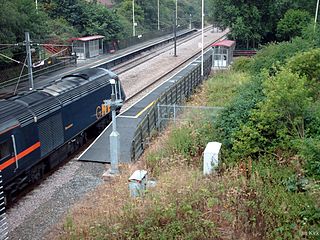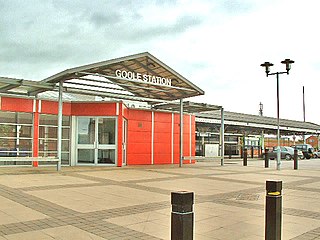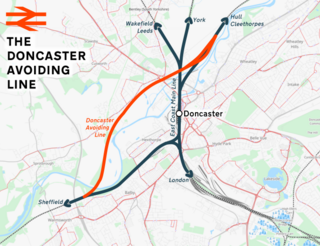
Doncaster is a city in South Yorkshire, England. Named after the River Don, it is the administrative centre of the larger City of Doncaster, and is the second largest settlement in South Yorkshire after Sheffield. Noted for its horse racing and railway history, it is situated in the Don Valley on the western edge of the Humberhead Levels and east of the Pennines. The urban subdivision had a population of 113,566 at the 2021 census, whilst the City of Doncaster metropolitan borough had a population of 308,106.

Sheffield station is a combined railway station and tram stop in Sheffield, England; it is the busiest station in South Yorkshire. Adjacent is Sheffield station/Sheffield Hallam University Sheffield Supertram stop. In 2017–18, the station was the 43rd-busiest in the UK and the 15th-busiest outside London.

Wakefield Westgate railway station is a mainline railway station in Wakefield, West Yorkshire, England. It is 10 miles (16 km) south of Leeds to the west of the city centre, on the Wakefield Line and Leeds branch of the East Coast Main Line.

Doncaster railway station is on the East Coast Main Line serving the city of Doncaster, South Yorkshire, England. It is 155 miles 77 chains (251 km) down the line from London King's Cross and is situated between Retford and York on the main line. It is managed by London North Eastern Railway.

Rotherham Central railway station is in the minster town of Rotherham, South Yorkshire, England. The station was originally named "Rotherham", becoming "Rotherham and Masborough" in January 1889 and finally "Rotherham Central" on 25 September 1950.

Swinton railway station is a railway station in Swinton, South Yorkshire, England. It has three platforms and a small bus station, and lies at the junction of the former North Midland Railway main line between Rotherham Masborough and Leeds via Cudworth and the former South Yorkshire Railway line to Doncaster.

Mexborough railway station serves the former mining town of Mexborough, South Yorkshire, England. It is a station on the Sheffield to Doncaster Line 7 miles (11 km) south west of Doncaster.

Fitzwilliam railway station is in the small village of Fitzwilliam, West Yorkshire, England. It is also the closest station to the nearby town of Hemsworth.

Darnall railway station is on the Sheffield to Lincoln Line and was built in 1849 to serve Darnall, a community about 3 miles (5 km) from the centre of Sheffield, South Yorkshire, England, and which later became a suburb of the city.

Thorne South railway station is one of two stations serving the market town of Thorne in South Yorkshire, England. The station is 9.75 miles (16 km) north of Doncaster on the South Humberside Main Line. It is unstaffed, and the only passenger facilities are standard shelters on each platform.

Goole railway station is a railway station in the port town of Goole on the Hull and Doncaster Branch in the East Riding of Yorkshire, England.

Selby railway station is a Grade II listed station which serves the market town of Selby in North Yorkshire, England. The original terminus station was opened in 1834 for the Leeds and Selby Railway. The Hull and Selby Railway extended the line in 1840 and a new station was built, with the old station becoming a goods shed. The station was rebuilt in 1873 and 1891; the 1891 rebuilding was required due to the replacement of the swing bridge over the River Ouse at the same time.

Bridlington railway station serves the seaside town of Bridlington in the East Riding of Yorkshire, England. It is located on the Yorkshire Coast Line and is operated by Northern who provide all passenger train services.

Spalding railway station serves the town of Spalding, Lincolnshire, England. It lies on the Peterborough–Lincoln line.
The South Yorkshire Railway was a railway company with lines in the West Riding of Yorkshire, England.

The River Don Navigation was the result of early efforts to make the River Don in South Yorkshire, England, navigable between Fishlake and Sheffield. The Dutch engineer Cornelius Vermuyden had re-routed the mouth of the river in 1626, to improve drainage, and the new works included provision for navigation, but the scheme did not solve the problem of flooding, and the Dutch River was cut in 1635 to link the new channel to Goole. The first Act of Parliament to improve navigation on the river was obtained in 1726, by a group of Cutlers based in Sheffield; the Corporation of Doncaster obtained an Act in the following year for improvements to the lower river. Locks and lock cuts were built and by 1751 the river was navigable to Tinsley.

Hexthorpe is a suburb of Doncaster, South Yorkshire, England. Historically part of the West Riding of Yorkshire, the area's shape resembles a rhombus, with borders with Balby and Doncaster town centre, separated by railway lines and the river separating the area from the villages of Sprotbrough and Newton. The Hexthorpe House was a well known pub in the area. Following a fire, the pub remained derelict for a few months and the remains were demolished in 2009. The old pub sign was saved and has now been erected in Hexthorpe Flatts Park.

Shirebrook North railway station was a railway station serving the town of Shirebrook in Derbyshire, England. It was on the Lancashire, Derbyshire and East Coast Railway running from Chesterfield to Lincoln. The station was also on the former Shirebrook North to Nottingham Victoria Line and the Sheffield District Railway. The station has since been demolished and housing now occupies parts of the site with some stub rails nearby serving a train scrapper.

Doncaster railway station was situated in the Hexthorpe district of Doncaster, South Yorkshire, England and was the original terminus of the South Yorkshire Railway.

The Doncaster Avoiding Line is a railway line, which as its title suggests, avoids the town of Doncaster and routes goods traffic, principally coal and steel, away from the main line station where it would have to cross from the Sheffield line to the Hull or Cleethorpes lines and cause a bottleneck.



















